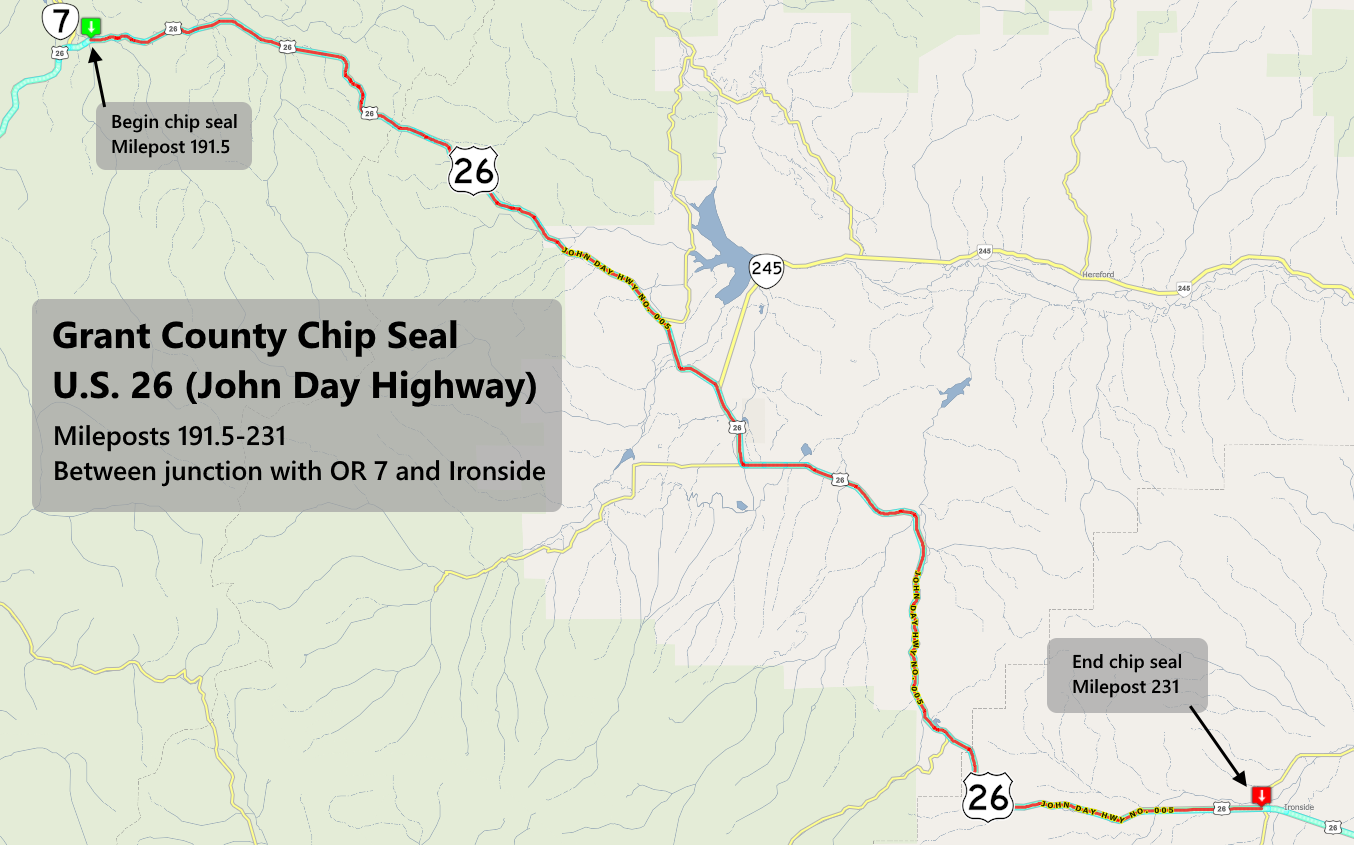Northeastern Oregon schools improve in key standards
Published 6:00 am Thursday, November 21, 2024

- Members of the Hermiston High School Class of 2024 throws caps in the air June 6, 2024, at the Toyota Center in Kennewick at the end of graduation. The Oregon Department of Education on Nov. 21, 2024, released its latest “At-A-Glance” school district profiles, which shows the Hermiston School District had 81% of its freshmen on track to graduate in four years, an increase of 2 percentage points over the 2022-23 school year.
Four years after the start of the coronavirus pandemic, many schools in Northeastern Oregon are seeing improvement in two of the state’s central indicators of student achievement — regular attendance and being on track to graduate after ninth grade.
The information was in the “At-A-Glance” school district profiles the Oregon Department of Education released Thursday, Nov. 21. The data is to give insight into how well districts are doing on metrics such as the success of students from disadvantaged groups and the percentage of students who graduate in four years. The data mostly comes from the 2023-24 school year, though graduation rates are from 2023.
Ninth grade students on track to graduate and regular attendance are two vital statistics, in part because they represent criteria to determine whether Oregon meets requirements of the federal Every Student Succeeds Act. The act focuses on students requiring additional support, such as those experiencing poverty or with disabilities.
Across Baker, Grant, Morrow, Umatilla, Union and Wallowa counties, ninth grade on-track and regular attendance rates generally exceeded statewide averages.
Staying on track
In Oregon, ninth grade students are considered on track to graduate if they’ve completed at least six credits by the end of the school year. Those who do not meet the threshold may struggle to catch up and graduate within four years. Identifying students who have fallen behind in ninth grade gives schools a chance to intervene early.
However, superintendents said it’s important to remember when looking at these numbers to note the student groups are different. The 2023-24 students may have different skills, needs, struggles and successes than the class of ninth graders before them.
As a whole, 85% of Oregon ninth graders were on track to graduate, a 1 percentage point increase over the 2022-23 school year. Regionally, 88% of Northeastern Oregon freshmen were on track after their first year of high school.
In Umatilla County, the Milton-Freewater Unified School District saw an increase of 6 percentage points over the year prior; more than 95% of ninth graders were on track to graduate. The high percentages held true across student groups as well.
About 91% of English learners, for example, were on track at the end of ninth grade to graduate. This is lower than last year’s more than 95%, but indicates a consistent commitment to keeping English learner students on track.
Meanwhile, Hermiston School District had 81% of its freshmen on track, an increase of 2 percentage points over the 2022-23 school year. Superintendent Tricia Mooney said the students who were not on track at the end of the last school year are receiving individualized support to earn the credits they need.
“It’s not as steep of a hill to climb the sooner we’re working on making up those credits,” she said.
Some Union County districts put up high numbers for freshmen on track to graduate. Cove, Elgin and Imbler school districts each had more than 95% of ninth graders on track to graduate, while North Powder had 95%.
Union and La Grande school districts were the outliers in the county, with the former seeing a 5 percentage point decrease and the latter seeing an 8 percentage point decrease. Union School District remained just above the state average with 86% of ninth graders on track to graduate, while La Grande came in at 77%.
In Union, Superintendent Carter Wells said that a significant number of families opted out of the statewide assessments, which could skew the school district’s data when it comes to performance on English learning and mathematics.
Baker and Grant counties saw an uptick in ninth graders on track to graduate. The Baker School District’s 79% on-track average is 4 percentage points higher than what was reported last year. That figure includes students in some of the district’s alternative programs, including the Baker Web Academy, which has hundreds of students who don’t live in Baker County. The on-track rate at Baker High School was 88%, up from 74% the previous year.
Grant School District in John Day reported an 86% ninth grade on-track rate, an increase of 5 percentage points over last year’s rate.
Grant School District is slightly above the statewide ninth grade on-track average of 85%, while Baker School District is more than 4 percentage points below the statewide average despite the gain from last year’s average.
Showing up matters
Students who attend more than 90% of their enrolled school days are considered regular attenders, which breaks down to about two absences per month.
“We know that when kids are in school, their academic achievement improves,” said Mooney with the Hermiston School District.
School districts in Northeastern Oregon generally saw increases in regular attendance in the 2023-24 school year compared to 2022-23.
Mooney’s district, the largest in Umatilla County, had regular attendance of 62%, below the statewide average of 66% and an average of 68% for the six Northeastern Oregon counties.
“That’s not the percentage we want to see,” she said. “We know that our kids need to be here in school.”
Still, the figure is 2 percentage points above the 60% mark the district had in the 2022-23 school year, which represents about 50 more students regularly attending school in 2023-24. In fact, almost all school districts in Umatilla County increased their percentages of regular attenders.
The same held true in other counties. In Union County, for example, Elgin School District had 70% regular attendance in 2023-24 — a 14 percentage point increase from the previous year.
Imbler School District was a close second with a 13 percentage point increase over the previous year — which left the school district at 86% of students with regular attendance. Cove and North Powder school districts saw increases of 8 and 4 percentage points, respectively. Cove School District had 79% of its students regularly attend school while North Powder had 85%.
As the largest school district in Union County, La Grande stayed steady at 66% regular attendance last year, right at the state average.
Union School District saw an overall decrease in students’ regular attendance in the 2023-24 school year. The district had 60% of its students regularly attend school last year — a 7 percentage decrease from the year prior.
Given that Union School District operates on a four-day school week, Superintendent Wells said “missing one day of school has extreme significance” for students.
He was disappointed to see the attendance rate, but is optimistic. Wells pointed to the work student success coach Rhondie Johansen is doing to improve attendance. Students with more than 90% attendance get entered into a raffle where they have the chance to win prizes. The school also has class competitions in which students can collectively earn rewards for their class, such as food or coffee.
Wells also is optimistic the new truancy ordinance in Union County will prove to be a tool the school district can use for extreme situations, as well as an additional incentive for parents and students to promote attendance.
Attendance in Wallowa County was up across the board in 2023-24. Wallowa School District saw the largest jump in regular attendance with a 26 percentage point increase — bringing the district up to 81% for student attendance. Joseph School District jumped from 65% to 78% regular attendance, while Enterprise School District was up 7 percentage points, with 75% attendance last year.
Grant School District in John Day experienced a rise of 3 percentage points over last year’s average to put its regular attendance at 73%.
The largest regular attendance drop in Northeastern Oregon has been in the Baker School District, where its 38% regular attendance average dropped 43 percentage points from last year, when 81% of the district’s students were regular attenders. It was the largest decline in the state.
Those numbers don’t tell the entire story, however. Baker Web Academy and Baker Early College are a pair of charter schools sponsored by the Baker School District whose attendance figures count toward the district average. Many of those schools’ students, particularly in the Web Academy, live outside Baker County.
Collectively, the schools make up 3,141 of the district’s 5,013 enrolled students and attendance at both was well below the state average. Baker Web Academy reported a 23% regular attendance rate for its 2,907 enrolled students, and Baker Early College reported a 7% regular attendance rate for its 507 enrolled students.
By comparison, every traditional school in the Baker School District with more than 100 students met or exceeded the statewide regular attendance average save for South Baker Intermediate School, which came in just below the state average at 63% but was up from 47% the previous year. The school has students in grades 4, 5 and 6.
At Baker High School, regular attendance was 70%, up from 66%; at Baker Middle School 68% of students were regular attenders, up from 60%; and at Brooklyn Primary, grades 1, 2 and 3, regular attendance was at 67%, up from 52%.
Grant School District in John Day experienced a rise of 3 percentage points over last year’s average to put its regular attendance at 73%.
The Morrow County School District bucked the regional trend, as its regular attendance rate dropped by 5 percentage points in 2023-24, down to 62%.
Marie Shimer, the district’s director of educational services, said the number is not where the district wants it to be. But she pointed out that the district maintains a high graduation rate. The 2024 graduation rates have not yet been released, but in 2023, Morrow graduated 97% of its seniors in four years.
Shimer attributed some of the low regular attendance to habits formed during the pandemic. Online lessons and assignments, she said, made some students think they could complete everything without showing up to class. To keep high school seniors and juniors engaged in schools, there’s been an effort at the district to increase options for taking community college classes as well as participating in paid internships.
With the end of truancy courts, Shimer said, there are no policies that have teeth to get a parent to the table to discuss their student’s attendance. Truancy court was a partnership between law enforcement and schools to address chronic absenteeism by threatening to fine the parents of truant students, but the piece of legislation related to the program was repealed in 2021.
Unlike some other counties, Morrow County has not introduced a new format for truancy citations, leaving the county’s schools to focus on a positive, reward-based approach to increase attendance.
Truancy ordinances
Some Northeastern Oregon counties have recently taken steps aimed at combating chronic absenteeism.
For example, Union County implemented a truancy ordinance earlier this year. It was developed by county officials, including District Attorney Kelsie McDaniel, Sheriff Cody Bowen, Commissioners Matt Scarfo and Paul Andres, and school superintendents.
“We use it as a tool, not as a punishment sanction unless we absolutely have to,” McDaniel said.
The ordinance, which is similar to a state law that was in place for years until a portion of it was repealed in April 2021, gives school districts and Union County the ability to issue citations to parents and the guardians of students who are chronically absent.
While the court can impose a civil penalty on the family of up to $500 for the first offense and up to $1,000 for each subsequent offense, McDaniel does not anticipate fines will be used often. In the past, judges have opted for creative solutions, such as requiring a student to join a sports team or to meet with the judge in chambers when the student finished school for the day.
Similarly, parents in Umatilla County now can be cited for “failure to supervise” if their student is consistently absent from school. The county recently began its Parent Effectiveness Program — the county’s new approach to truancy. The program was rolled out about a month ago with support from all the districts in the county, said Commissioner Cindy Timmons.
“The idea is it gives school districts leverage to bring parents to the table,” she said. “The whole point behind PEP is not to put parents into court, it’s to work with them to get their children back in school.”
The programs have not yet been in place long enough to judge whether they’re effective. Next year’s regular attendance numbers could offer an early clue as to their success.






